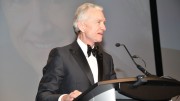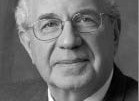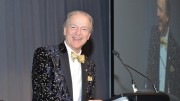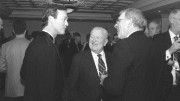The Canadian Mining Hall of Fame welcomed four extraordinary individuals during the thirty-second annual induction ceremony in January at the Metro Toronto Convention Centre. Industry giants Jerry Asp, Alex Balogh, Hans Lundberg and Eberhard Scherkus were celebrated for their exemplary careers and key contributions to the mining industry.
Master of ceremonies Anthony Vaccaro, group publisher of The Northern Miner and The Glacier Resource Innovation Group, acknowledged he had big shoes to fill after Pierre Lassonde relinquished the role last year. Vaccaro paid homage to his predecessor’s 18 years as MC with video clips of some of Lassonde’s best lines (“For those of you who don’t know me, that’s okay, I don’t know you either” and “What’s the difference between air miles and the Maple Leafs? At least air miles earn points.”)
“Pierre, your charm, your classiness, your sense of humour and your golden sense of style, which no one could ever emulate, has helped build this event into what it is today,” Vaccaro told the more than 1,000 attendees.

Anthony Vaccaro, The Northern Miner group publisher and master of ceremonies, at the Canadian MIning Hall of Fame induction in ceremony Toronto. Credit: CMHF.
Vaccaro kicked off the evening with black and white slides from The Northern Miner’s archives – joking that he had spotted inductee Ebe Scherkus in one photograph from 1929 taken after a plane crash in the Arctic. (Scherkus was born in 1952). “Apparently Agnico Eagle’s great success in the early days was because they had Ebe poking around up there,” Vaccaro joked.
On a more serious note, Vaccaro summarized the highs and lows of the year – from soaring mergers and acquisitions activity to protest movements to the deadly tailings dam collapse in Brazil. He closed his remarks noting that the advent of civilization has been defined in metallic terms. “Historians use the terms Copper Age, Bronze Age and Iron Age to define successive epochs in which humanity rose up out of a more primitive state of existence,” he said. “Now of course some of these protestors might prefer that we go to back to the Stone Age. To which I say, so be it, but we’ll need to mine that too.”
Jerry Asp
The first inductee of the evening was Jerry Asp, one of Canada’s most prominent indigenous leaders. As chief of the Tahltan Nation as well as an entrepreneur, he understood better than anyone his community’s concerns about development on their traditional lands but also how the mining industry could be a positive force bringing employment and opportunities. In 1985 he founded the Tahltan Nation Development Corporation (TNDC) and started negotiating partnerships between the TNDC and mining companies, starting with the Golden Bear mine in 1988, which required a 160 km access road across Tahltan land. Asp brokered the first Impact Benefit Agreement in the history of British Columbia, which included road construction and other contracts at Golden Bear. TNDC did a joint venture with RD Construction and within three weeks bought $3 million worth of equipment to get the project underway.
The TNDC became Canada’s largest native-owned and operated heavy construction company and TNDC signed contracts at other mines including Eskay Creek and Red Chris. Today the TNDC has expanded and works on many aspects of mine operations – from catering to IT services. “When we first started negotiating with mining companies we already had the Tahltan Resource Development Policy in place,” Asp told the audience. “But as significant as that policy was, it was the fact that we wanted our people developed along with our resources that made all the difference to our nation’s success.”

Canadian Mining Hall of Fame inductee Jerry Asp. Credit: CMHF.
Asp also was a founding member of what became the Canadian Aboriginal Minerals Association and co-founded the Global Indigenous Development Trust to forge alliances between indigenous communities and mining companies around the world.
“He was a real trail-blazer,” Glenn Nolan, vice president government affairs at Noront Resources, said of Asp in a tribute video. “He showed that they and us—we can actually work in this industry in a meaningful way—contribute in a meaningful way, and build those bridges between the two different cultures.”
Asp’s grandfather was born in Sweden and after jumping ship in Baton Rouge, Louisiana, worked his way up through the logging camps of Wisconsin. He then set off to look for gold in the Stakine, where he met Asp’s grandmother in 1919. They moved to Portage Landing in 1921 and then bought the entire town when it was put up for sale in 1947. Asp chose to work in mining because he loved being outside and in the bush. He worked his way up from dishwasher to diamond driller and then to crews underground. He spent seven years at the Tantalus Butte coal mine and then went back to school to study contracting and project management.
Asp began his acceptance speech with an old saying: “If you see a turtle on a fence post, you can be sure that he had help getting up there, so like the turtle, I’d like to thank a few people who helped me reach this goal.”
In addition to Ida, his wife of 52 years, their four children, eight grandchildren and six great-grandchildren, he thanked the Tahltan leadership for their “foresight and vision” and for carving a path “for a better way of life with meaningful opportunities for our people.” He noted that his proudest achievement other than his family and siblings, was taking the Tahltan nation “from abject poverty to affluence and helping to break the cycle of welfare culture in the Tahltan Nation forever.”
“When I started at the TNDC in 1985, we had 98% unemployment in the winter and 65% unemployment in the summer on our reserves; 80% of our members were on welfare, we had a serious alcohol and drug problem, a high suicide rate and very low education standards,” Asp said. “By 2006, we had zero unemployment in the summer and 5% in the winter and our suicide rate dropped to zero and we had very few people on welfare.”
Last year 46 students from the community graduated from grade 12 and six or seven more from colleges and universities, he added. In May it graduated its first mining engineer and there are at least another 12 to 15 people enrolled now in accredited apprentice programs.
Asp also noted that mining and exploration projects today contribute about $30 million in wages and contracts annually to Tahltan members. “I’d like to thank our current leadership for carrying on the work that it started and like to thank the mining industry for being a catalyst that helped move our nation from abject poverty to affluence and for that I hold my hands up to you.”
Alex Balogh
Alex Balogh was the second inductee of the night. He led and helped build Falconbridge and Noranda into two of Canada’s most successful mining and metallurgical empires.
He also developed and implemented key innovations in copper production. The first, while as a shift foreman, was the Gaspe puncher, which significantly improved the operating efficiency and working conditions of copper converters. “There was a young chap on my shift who insisted that the puncher was too arduous a task and there’s a much easier way to do it,” Balogh said during a tribute video. “Fortunately, we were both working on shift, so we secretly assembled one—that’s how it was born.” (Heath & Sherwood licensed the machine and since the late 1960s, over 250 units have been sold to copper smelters and some nickel smelters around the world.)
Balogh is also credited with the introduction of Noranda’s continuous smelting and converting process at the Horne smelter in Quebec. The pioneering process improved energy and environmental efficiency and reduced sulphur dioxide emissions—thereby mitigating the acid rain issue. “I think if you ask me honestly, I would take no credit for it because it was true teamwork,” he said on the video.

Canadian Mining Hall of Fame inductee Alex Balogh. Credit: CMHF.
“Alex’s technical breakthroughs and his focus on safe, environmentally responsible resource development helped create the strong platform of sustainability that underpins the entire Canadian mining industry today,” Don Lindsay of Teck said during the video.
Born in Montreal to Hungarian parents, Balogh started off studying chemical engineering at McGill University before being lured into metallurgy with a scholarship, and obtained a bachelor’s degree in metallurgical engineering. After graduating in 1954, he started his career at Noranda (Gaspe Copper), working his way up the ranks to vice president of Noranda’s copper and zinc operations by 1976. He oversaw Noranda’s investment in Falconbridge in 1989, and became president and CEO of both companies in the 1990s. During this period he developed three mines: the copper-zinc Antamina mine in Peru; the Collahuasi copper mine in Chile, and the Raglan nickel mine in Quebec—all of which are still active today.
In his acceptance speech, Balogh thanked those who had played a key role in his career, including Albert Pelletier, “a self-made instrument technician whose stubbornness and creativity led to the development of both the Noranda reactor and the Gaspe puncher.” He thanked Pierre Henri, a Gaspesian chicken farmer who painted safety signs for Gaspe Copper and was editor of the Gaspe Voyageur, a community newspaper Balogh co-founded with R. Ford that covered the Gaspe region for more than a decade. Henri went on to become a vice president of Pratt and Witney. Others of influence included Scottie Gerrie, Mike Knuckey, Graham Farquharson, Philip Mackay, David Kerr, Bill Brissenden, Alf Powis, David Bumstead, Bill Deeks, Frank Frantisak, Lance Tigert and Gerry Hatch.
The Balogh-Fortier team also played a special role in his life, he said, referring to his wife and four children. They “were obliged to move their home several times and without exception valued the experience,” he said, including his son Lou, who has Downs Syndrome and is the heart and soul of the family. “He’s mentally challenged,” Balogh said, “and my family will be the first to claim that our characters were all built by Lou.”
Hans Lundberg
The third inductee of the evening was Hans Lundberg (1893-1971), a visionary pioneer in the development and application of geophysical and geochemical methods in Canada and around the world. He was the first to conduct ground geophysical surveys in Canada, the first to try geochemical prospecting in Canada, and the first to combine the two. Among his greatest achievements was the first application of airborne geophysics in the 1940s.
“I would say that Lundberg was one of the fathers of geophysics in Canada, but other people who are geochemists may say that he was one of the fathers of geochemistry in Canada,” Richard Smith, a geology professor at Laurentian University’s Harquail School of Earth Science, said of Lundberg in a tribute video. Added Ken Witherly, president of Condor Consulting: “He actually created the core of people that became the founders of modern exploration geochemistry in Canada.”

Hans Lundberg.
Born in Sweden, he graduated from the Royal Institute of Technology in Stockholm in 1917 and became a lecturer at the institute. During his twenties, he and a colleague developed a new variation of “equipotential” surveying that was more sensitive and practical for field use in a cold climate and led to two important polymetallic discoveries in Sweden (Kristineberg in 1918 and Bjurfors in 1922). “The equipotential methods that he invented with his colleague was a technique where you would inject current into the ground at a very low frequency, essentially what’s known as the direct current technique,” Smith explained in the video. “You would measure the potential on the ground and find places where the potential was equal. By looking at how that potential distorted itself on the surface of the ground, you could work out if there are conductive features underneath.”
He moved to Canada in 1926, and his ground geophysical surveys led to two major discoveries in Buchans, Newfoundland (Lucky Strike and Oriental). “They did a survey in a swampy area where there was no obvious geology. No sooner did they dig down below the cover, I recall, then they found mineralization,” Smith said.
“They transformed something that had been of interest into what became a very important mine, the largest mine of its kind in Canada at the time and that basically sealed his reputation … he became a rock star,” added Witherly.
After becoming a citizen in 1936, Lundberg also helped the government during the war effort to meet its strategic mineral resource requirements.
He started aerial magnetic surveys in 1946 in Ontario and Quebec, using Bell helicopters and fixed wing aircraft, and in 1947 conducted airborne trials of an electromagnetic (EM) system. In the 1950s he pioneered airborne radiometric surveying, which has been used extensively in uranium exploration. Lundberg was also ahead of his time in areas of biogeochemistry, the sampling of lake sediments and boulder tracing. “He was one of the first people in Canada to buy a helicopter,” Smith said, “and he and his son would go out and collect the geophysical data.”

Kim Lundberg accepts the award for inductee Hans Lundberg, wearing his late grandfather’s suit. Credit: CMHF.
Lundberg’s eldest grandson, Kim Lundberg, accepted the award wearing the suit his grandfather had worn when he was granted his doctorate in geophysics from the King of Sweden in 1956. The doctorate was awarded for his life work in geophysical spot prospecting, exploration and mineral finds, particularly in Sweden but also elsewhere on the globe, his grandson said. Kim Lundberg gave special thanks to his grandfather’s flying team—“the ground crew and the people who actually flew the airplanes for his geophysical survey using magnetometers,” he said. “Without this team none of this would have happened and it was an extraordinary team. They ran a lab north of Toronto in the late 1940s and 1950s developing all the machines that he made or used.” The team included Lundberg’s son Sten, a pilot during World War II.
In his speech, Lundberg recalled family gatherings at his grandfather’s house in the 1950s where he displayed samples from his many mineral finds and interesting collections of Indigenous items from his prospecting missions in northern Canada and the Arctic. He talked about his grandfather’s other passions—singing and dancing, classical music (Beethoven was his favorite), and his stamp collection. Lundberg thanked the Canadian Mining Hall of Fame for recognizing his grandfather’s wildly successful career, and The Northern Miner, Peter Newman and Pierre Burton and others for writing about him.
Ebe Scherkus
Ebe Scherkus helped build Agnico Eagle Mines from a one mine company with 400 employees to a top gold producer with nine mines in Canada, Finland, and Mexico and more than 5,700 employees.
After graduating with a degree in geology from McGill University in 1975, Scherkus worked for several companies—from mine geologist to mine superintendent and project manager — before joining Agnico in 1985 as a project manager at the Dumagami mine, which became the LaRonde mine. By 1998 he had been promoted to chief operating officer and to president and COO by 2005. He remained in that role until his retirement in 2012.
Among his accomplishments at Agnico was turning the struggling LaRonde mine into a productive operation, which has been expanded at least four times. (LaRonde’s 2.2-km deep Penna shaft is the deepest single-lift shaft in the Americas.) “LaRonde will ultimately end up mining out being the largest gold-bearing, massive sulfide deposit in the history of the world,” Sean Boyd, Agnico Eagle’s vice chairman and CEO, said in a tribute video. “We’ve mined over 5 million ounces. We’ll likely mine 10-plus-million oz. there.”

Canadian Mining Hall of Fame inductee Ebe Scherkus. Credit: CMHF.
Scherkus, who went on to qualify as a geological engineer, also developed the Goldex and Lapa mines, as well as two mines in Nunavut: Meadowbank and Meliadine. Meadowbank, Agnico’s first mine in the Arctic, poured its first gold in 2010 and by 2015 had produced two million ounces. Meliadine started commercial production last year.
“We wouldn’t be here today ready to produce almost 2 million oz. of gold next year if it wasn’t for Ebe’s contribution,” Boyd said in the video.
In his acceptance speech, Scherkus joked that he knew he was the last inductee of the evening and that everyone probably just wanted the awards dinner to end. “I know you’re all thinking, ‘Hopefully he doesn’t speak too long, we are out of wine and we’d like to go back to the bar and renew old acquaintances,” he said smiling. “But as Ricky Gervais said [at the recent Golden Globes], ‘I don’t care!’”
“In today’s nomenclature, we ended up being disrupters in the 1980s,” he said of Agnico. “We were upstarts surrounded by Placer Dome, Lac Minerals, Cambior, Inco, Barrick and Noranda.”
Scherkus thanked a long list of former colleagues including Boyd, Paul Penna, Louise Grondin, and Brian Meikle, among many others. He also thanked the Abitibi region and the towns of Rouyn-Noranda and Val-d’Or, “towns with a rich multi-cultural mining tradition,” and the province of Quebec, “one of the best places for resource development on the globe.” The list of mining companies “who operated mines or got their start there is a Who’s Who of the mining industry.”
He reserved the biggest thanks for his wife Linda and their three children. “Mining is tough. But it’s also tough on families. Long hours, travel, and often a very grouchy dad….They have seen and experienced it all.”
Scherkus and Linda were high-school sweethearts and the couple have been married for 52 years. “She was there when I got on the midnight bus and headed off to university in Montreal. … We grew up together. … She kept the home fires burning, and she also didn’t know the meaning of the word no. Open to any adventure at any time … She’s my best friend, soul mate and glue that held it all together.”






Be the first to comment on "Mining Hall of Fame awards gala welcomes four inductees"